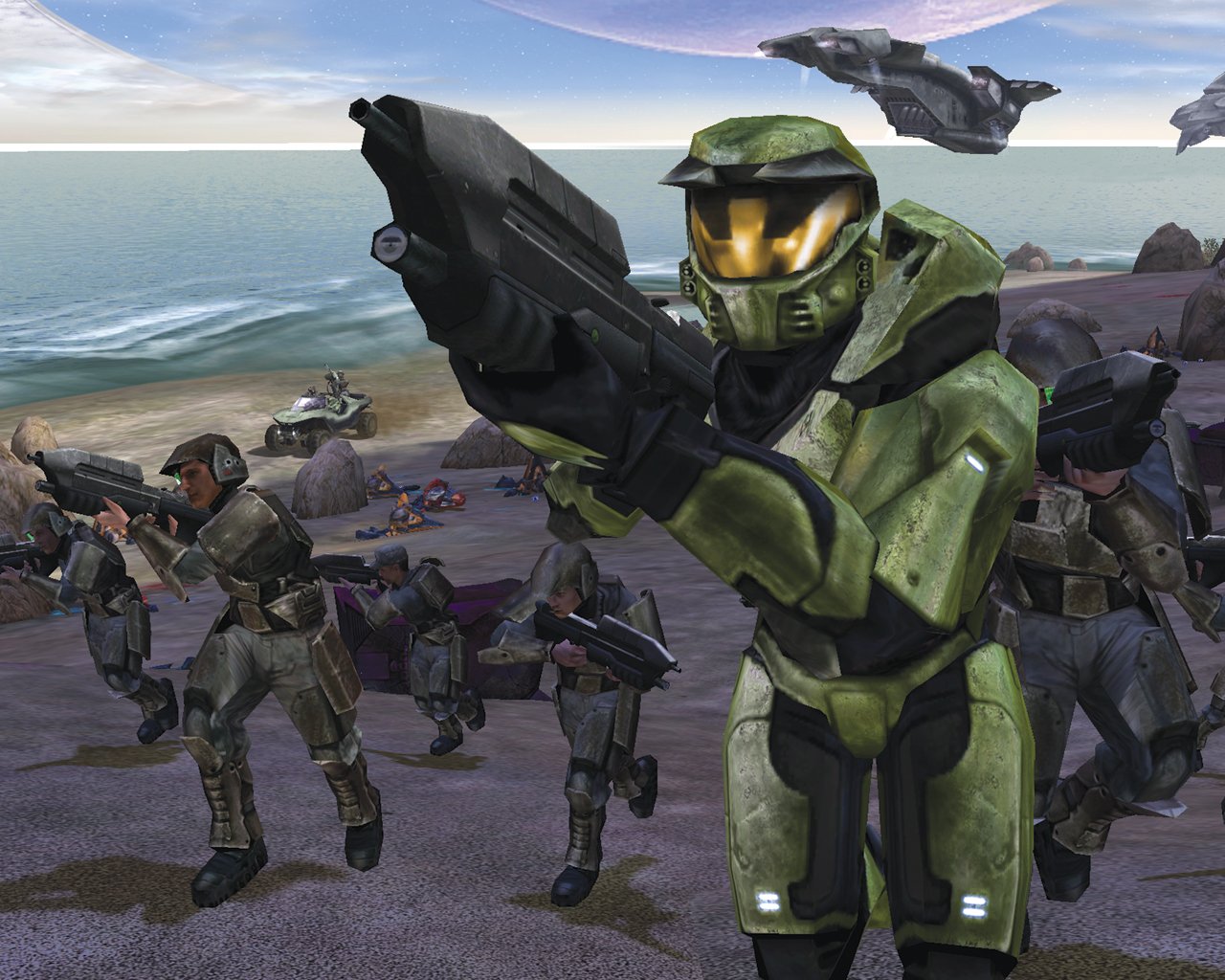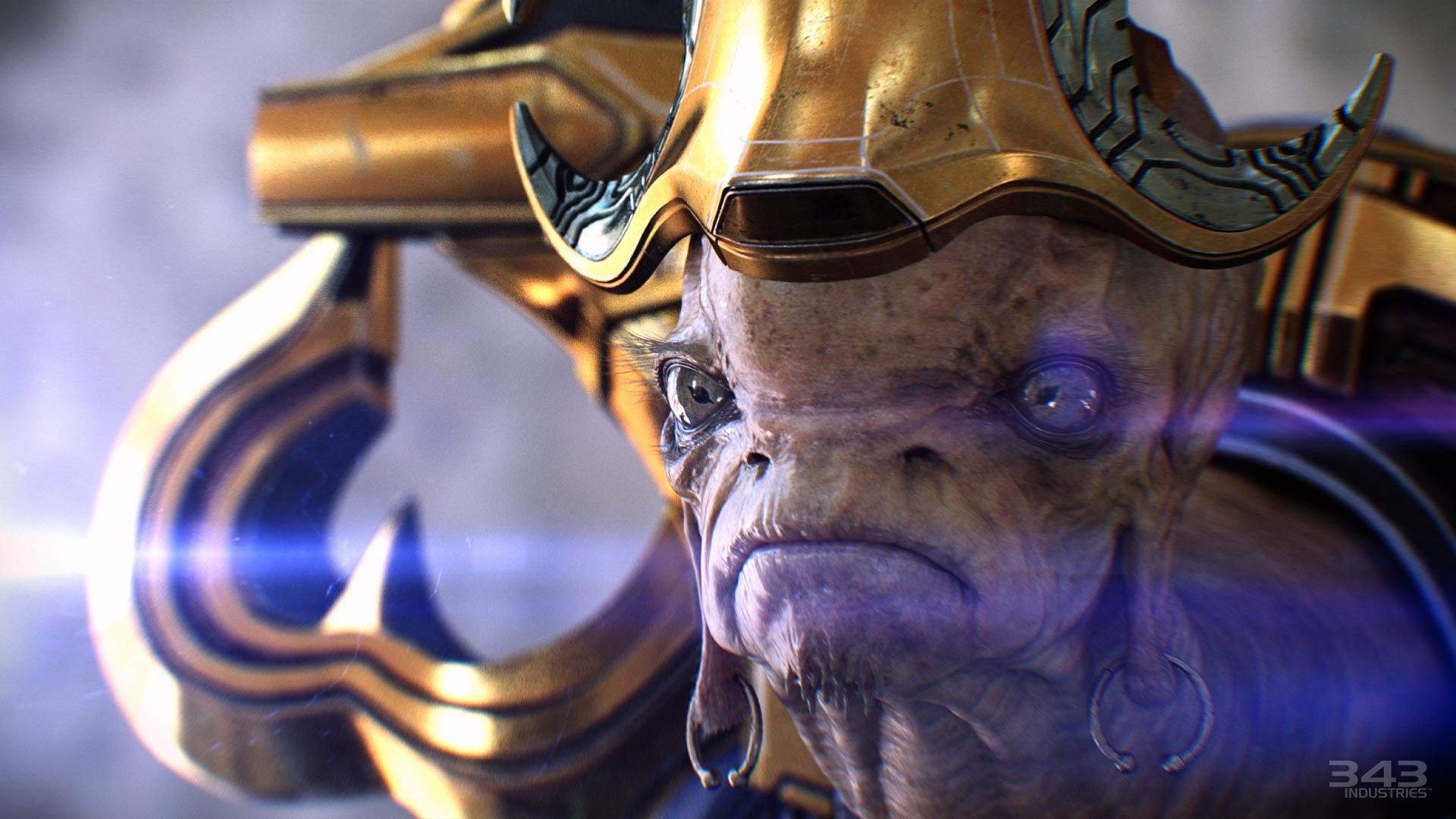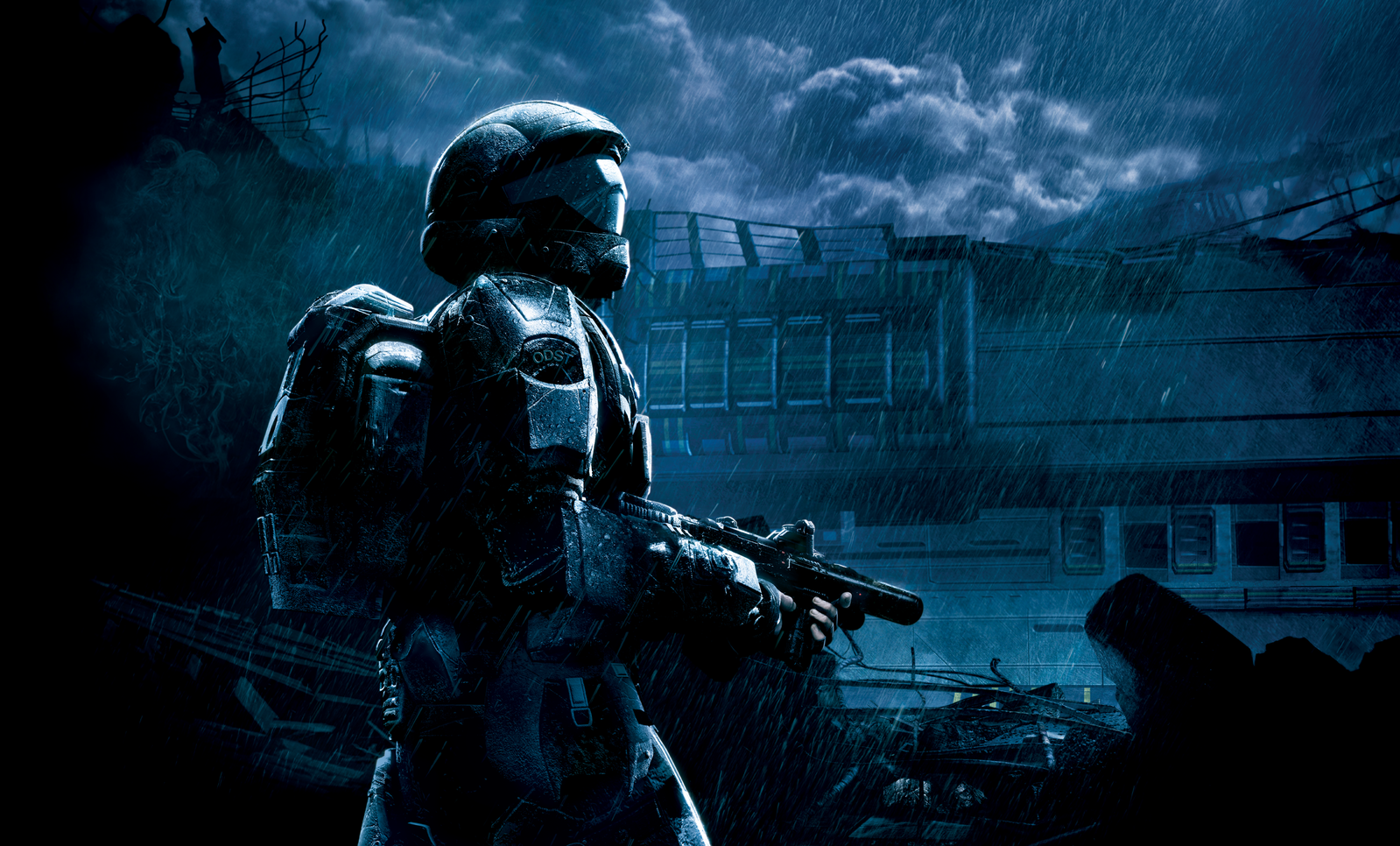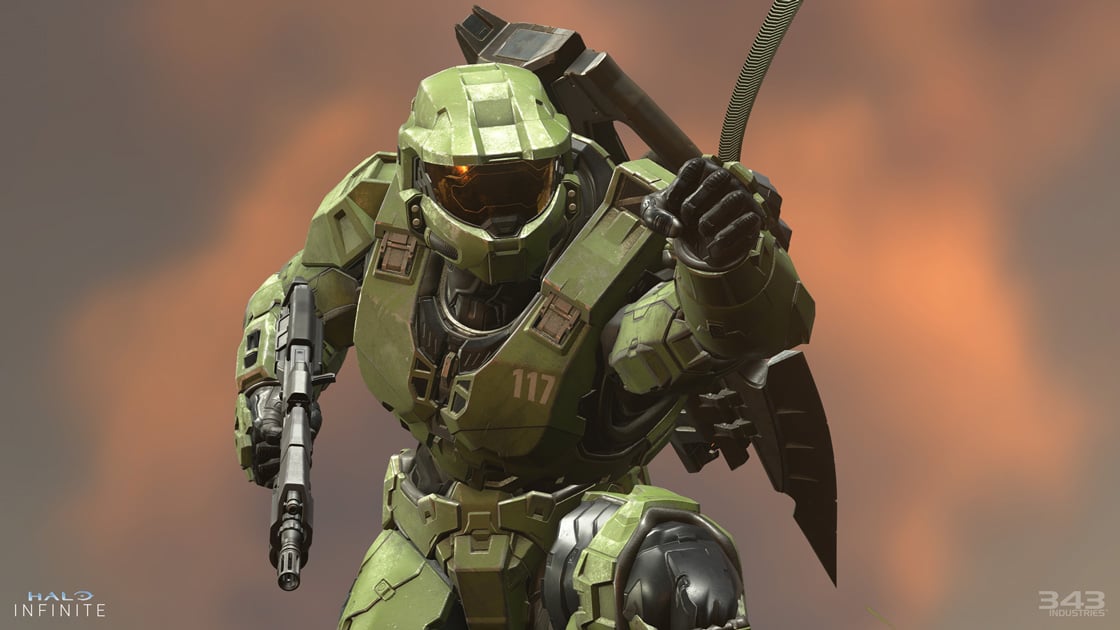Review
Halo: My Thoughts
- 4026 words
- –
If you had asked me at the start of 2023 my opinion on Halo, I wouldn’t have had anything to say. I’d played 10 minutes of multiplayer with my cousin the better part of a decade ago, but that was it. Since then, I’ve played through every single mainline Halo game, from Combat Evolved to Infinite. This article catalogues my opinions on each of the games in the order I played them. I played all of the games on my Xbox Series S as part of the Master Chief Collection (MCC), with the exception of 5 and Infinite, which I played through their standalone games. I’ll only be discussing the campaigns, as I have scarcely touched the multiplayer.
I’ll be avoiding spoilers for the most part, but if I’ve got any specifics to mention, I’ll place them in a “Campaign Specifics” drop-down at the conclusion of the relevant entry. This means that even if you haven’t touched the series, you can rest assured this article shouldn’t ruin your experience. That said, just go play the games; they’re generally worth it. I also just want to give thanks to my friend Sebastien, who advised me to get into the series. ‘Twas a good call.
Halo: Combat Evolved
Halo: Combat Evolved, often abbreviated to CE, is the first game in the series. It sets up what is to come and sets it up well. The gunplay feels terrific, the gameplay is sublime, and the story holds audience attention without ever getting in the way.
Right off the bat, I’d like to mention the Anniversary edition. Releasing in 2011, it features a complete overhaul of all the graphics. While it looks fantastic in the right conditions, it has some issues. Many of the textures and models are ripped straight from Halo 3 and Reach 1 and aren’t faithful to the original release, which alters the tone and impacts the story telling.
This is especially prevalent in later missions, where what should be dark, dingy, and foreboding is bright, sterile, and innocuous. The palette is more saturated, and the textures are detailed to the point of being overwhelming. Where the original graphics tie into the horror element of requiring you pull out a flashlight to navigate a dimly lit, unfamiliar environment, the Anniversary graphics will have you trying to lower your brightness to avoid a visual overload.
Not only that, but the bounding boxes of countless objects don’t line up quite as you’d expect. On the occasion that I attempted playing with the anniversary graphics, I consistently found disparities in level geometry eating my bullets.
That’s why, despite the original graphics having most definitely aged, I personally chose them for my playthrough. The new ones can be a spectacle when presented correctly, but otherwise miss the mark and degrade the experience. Fortunately, you can toggle between them at your convenience. It can genuinely be somewhat fun to flick back and forth to observe the changes.

With my graphical gripes out of the way, my mind turns to the iconic theme CE introduces. I don’t quite know how to express my love for this theme; it’s superb. It is super versatile, with each variant cleanly slotting into the situation that calls for it. Whether it’s a slow piano version in an emotional moment or a fast, intense version in the heat of battle, the theme, in conjunction with the rest of the soundtrack, immediately acts to define an atmosphere and pull the audience into the moment.
I’ll also note that the Anniversary edition comes with a new, re-recorded, remixed soundtrack. It’s different and not completely faithful to the original. While not necessarily bad, it captures the wrong mood and changes the overall ‘sound’ of the original. Most of this comes from the mixing, where subtleties are lost and emphasis is redirected.
Halo has some deep religious undertones that manifest throughout the series, starting with CE. Perhaps most blatantly, the name of the game, Halo, refers not just to the ring-world on which it’s set but also the crown of light surrounding the heads of sacred people in many religions. The vocals of the soundtrack derive from Gregorian chants originating from the Roman Catholic Church, and there are many finer, more subtle references throughout that, while not necessarily obvious in CE, proceed to establish themselves in later entries.
Combat Evolved’s campaign opens strong with a solid introduction. It starts off with some weapon-free navigation of the ship before diving into some exposition and then transitioning into close-quarters corridor-based combat. This serves to help new players grasp the basics of movement, positioning, and operation of their weapons in a forgiving environment while not feeling overbearing for anyone with a gaming background.
It then proceeds to, like many good games, slowly but surely introduce more mechanics, weapons, and interactions without ever feeling overwhelming. It’s not perfect, and the weapons aren’t necessarily super balanced (the pistol in this game may as well be a sniper rifle.), but it ticks the most important box. It’s fun.
If you’re looking to get into the FPS genre, then it’s a good game to start with. If you’re looking to get into Halo, then it’s the game to start with 2. It’s also a good game to stop with, if you just want to dip your toes in and aren’t sure if Halo is your cup of tea. It has a nice conclusion that, while being rather open-ended, supplies an easy and satisfying stopping point.
Campaign Specifics
There is a certain sense of awe that sets in post-crash as you step out of the escape pod and look up for the first time. Seeing Halo wrap into the sky for the first time is really something to behold.
While pretty consistently a stellar experience, one level stands as an exception: The Library. Not only must you deal with the ever-irritating 343 Guilty Spark for the level’s entirety, but you must also battle through several monotonous, repetitive, copy-pasted, Flood-filled chambers that are a clear symptom of Bungie’s development crunch.
Halo 2
Halo 2 looks at CE, throws out what didn’t work, iterates on and improves what did, and then cranks everything up to 11. The stakes are high, and the quality is higher. The seamless integration of intense action sequences and stellar storytelling create an immersive experience that kept me firmly on the edge of my seat.
Where I felt the need to complain about CE’s Anniversary graphics, I feel the need to celebrate Halo 2 Anniversary’s. You can quite comfortably play the game with or without the overhaul and be confident you’re experiencing the game to its fullest. They remain faithful to the original while looking stunning, and, much like with CE’s, they can be toggled at will to verify this.
Of particular beauty are the cutscenes. Crafted by Blur Studio, the cutscenes are marvellous. They’re detailed and crisp, looking more sharp and real than reality itself, but not overwhelmingly so. Part of my decision to play with Anniversary graphics was just to ensure I didn’t miss them.

That said, the original graphics don’t slouch either. While there are some slight regressions thanks to a pivot in lighting tech mid-development, models are much more detailed, meaning the game takes on a less stylised, more ‘realistic’ approach.
While Halo 2 keeps most of its predecessor’s music, it also manages to elevate it with the inclusion of some truly epic electric guitar. The guitar elevates the music to something somehow even more exhilarating than what CE accomplished.
Much like with CE’s Anniversary release, Halo 2 Anniversary features a re-recorded and remixed re-release of the soundtrack. Thankfully, much like with the graphics, it takes a step up from the CE’s. While some tracks have unfortunately been replaced, it’s generally mixed much better and more faithfully to the original, making it an excellent listen.
The gameplay sees several improvements, with dual wielding, destructible and hijackable vehicles, and reduced fall damage taking the game a monumental step forward. These enhancements somehow push the game into something even more dynamic and immersing than CE.
Starting very similarly to CE with a subtle close quarters tutorial, it doesn’t take long to diverge into a much richer, more expansive story. This story is punctuated by writing and choreography that would later be improved in Halo 3.
One thing that does irk me is the ending. The game concludes with quite the cliffhanger thanks to Bungie, more or less, creating the entire game in about 9 months and having to slice the game pretty much in half to push it out in time. That said, the half they sliced off went on to lay a solid groundwork for the next game in the series, Halo 3.
Campaign Specifics
Like many other players, I was a bit confused when I loaded into the sixth mission, The Arbiter, and found myself playing not as the Chief, but as the alien from the cutscene. While it was a bit of a shock at first, it didn’t take long to get acclimated, and his ability to enable 10 seconds of active camouflage introduced interesting gameplay opportunities.
Halo 3
While being the conclusion to Bungie’s original trilogy, Halo 3 is really the conclusion to Halo 2. It serves to tie up 2’s cliffhanger and loose ends while itself being a complete package with a well-fitting conclusion that provides appropriate closure.
Being released relatively early into the 360’s lifespan, Halo 3 may not compare to the graphical fidelity that 360 games would later achieve, but it has a lot of charm and a distinct art style that more than makes up for it. The cutscenes of 3 expand on the direction of 2 and are animated in an almost cartoony nature that provide a wonderful sense of energy that cement them as my favourites of the series and perhaps my favourite part of Halo 3 altogether.
I can’t say it’s my favourite game in the series from a gameplay perspective, as it didn’t really add much to the experience other than deployable equipment and the gravity hammer. While I didn’t find myself using the equipment all that often, I did love the gravity hammer. A super powerful melee weapon that sends enemies into the stratosphere with ease. The lethality and power paired with its animations make it feel weighty and menacing. The game also excelled at continuing the story and did an admirable job broadening the in-game universe.
Halo 3: ODST
ODST follows the Orbital Drop Shock Troopers, a subset of the UNSC marines that drop in from the sky in specialised pods to aid in battle. This is the first game in which you don’t play as Master Chief at all. Instead, you take the reins of the Rookie, an ODST. This leads to the game being a captivating departure from the previous games in the series. You don’t get the armour or strength of a Spartan, and this shows in the gameplay.

This game is notably different to the rest of the series, and it’s best experienced on a harder difficulty. ODST plays best when a slip-up ends you in the most dire of situations. I had the most fun when, on recommendation of my friend Sebastien, I played on a harder difficulty on a dark, raging evening. You need to feel scared and take care because you aren’t playing as the Master Chief. You’re the marines that you’ve witnessed fall around you during the last 3 campaigns. You must take much more care as you play, although it would have been nice for the difference to perhaps been a tad more pronounced.
The graphics in this game are a noticeable, albeit minor, step up from Halo 3. Everything from the textures to the lighting, just looks better. It’s also bathed in that sepia tone that the seventh generation of game consoles are known for.
The music of this game, much like the gameplay, is a sound departure from Halo tradition. Gone is the orchestral grandeur of previous games, and in is smooth jazz (blues is probably a better description, but smooth jazz is much more humorous). While it may seem peculiar, it’s oddly fitting. The blues, jazz, and noir influences have a notable impact on the game’s urban and mysterious setting. It relies on ambient sounds to create an atmosphere that captures the feeling of walking through dark, rain-soaked streets, perfectly constructing a sense of isolation and introspection.
The story is told by very different means, with the player piecing it together through flashbacks, the environment, and objects littered throughout it. The story also differs in its order. Where previous campaigns were strictly linear, ODST allows the player to play the missions in the order they choose. While this is a lovely idea, the missions still lead into each other, and the player is forced to go out of their way to play them any differently than was intended.
Overall though, this different style of storytelling creates a very unique experience that pairs elegantly with the style of gameplay ODST strives for.
Halo Reach
Reach is, in my opinion, the best game in the Halo series. I won’t say too much here out of fear of spoiling it for someone, but it is so very good. In all honesty, I came very near to giving up on Reach towards the beginning. After having already played four games from the series, I was starting to tire. Following ODST, I kinda just wanted to jump back into the story as Master Chief and was chasing that high of the original trilogy. I’m so extremely glad I saw it through though for the game is stunning in every aspect.
Gameplay-wise, it improved on the equipment mechanic from Halo 3 by incorporating Armour Abilities, a more varied, refined equipment system. It also improves on the weapons, with everything having a distinct and recognisable purpose. The enemy AIs also see a marked improvement and are considerably more fun to fight with troops, such as the Elites, moving a lot more erratically.
The music of Reach is wonderful. Much like ODST, it strays away from the series’ iconic Gregorian chant. Reach doesn’t wander as far as ODST though as its vocals and strings remain very reminiscent of the theme found in the mainline games. What really makes Reach’s soundtrack is the game’s simple leitmotif, as heard at the start of Long Night of Solace. The swelling strings instantly pull me into the melancholy feeling of Reach.
Being released towards the end of the Xbox 360’s lifespan, the graphics are a huge jump from anything seen in the Halo series previously. This is unfortunately the last game in the series worked on by Bungie, the series creators.
Campaign Specifics
I touched on almost giving up on Reach. I felt this way for a number of reasons. The first level, Winter Contingency, was just kinda dull. It didn’t do anything really interesting, and that set the tone for the first half of the game. Don’t get me wrong, it wasn’t terrible, just alright. Where it really picks up is with the level Long Night of Solace. The story starts to get deeper, the tone darkens, the stakes increase.
Members of Noble team start dropping, and the game takes on a whole new feeling. A feeling of emptiness as the impending doom setup from the opening starts to reach you. As your team slowly dies and you’re tasked with delivering Cortana to the Pillar of Autumn, it just clicks. The game simply falls into place.
What really cemented my love for Reach was the epilogue. As you fight the losing battle against the Covenant on the planet’s surface, there is nothing you can do but try to survive. You can’t keep them off forever, and nothing you do will change the looming outcome. Your death is imminent, just as the very start of the game alluded to.
Halo 4
Halo 4 is pretty good. It’s not the best, but it’d be a misjustice not to say it’s a worthy addition to the series. This is the first game to be developed exclusively by new series holder, 343 Industries, a subsidiary of Microsoft constructed exclusively for creating Halo games.

Prior to getting into Halo, my modern AAA gaming experience was very much limited. I was a bit young for shooters when the 360 was in its prime and mostly used the console for Kinect games and a bit of Minecraft. I was shocked to see just how well Halo 4 holds up. It’s hard to comprehend that within one console generation we went from Halo 3, to Halo 4. It’s not perfect by modern day standards, but it’s still impressive and holds its own.
This makes it all the more a shame that the art style lets it down. Styling is repetitive, with very little variation, and what does exist spits in the face of the Bungie games. Were it a unique title this would be a non issue, but to throw away what had been so well defined left me disappointed. It still looks good, but it could have been so much better.
The new enemies, the Prometheans, also weren’t my favourite to fight. Unlike the Convenant, they have no personality. Grunts chatter and show cowardice. Elites are big, burly, and lead the fight. Jackals hang back and attack from a distance. Each are unique and seem like they could exist outside the context of combat.
All the Prometheans are emotionless husks that exist purely as things to shoot at. The weapons they drop, while incredibly well designed, are dull to use and run out of ammo frequently. This would be a minor issue if they weren’t all bullet sponges that take a lifetime to kill. Unfortunately, you can’t use the UNSC weapons you’ve grown familiar with either, given that there is next to no ammo for them around.
I don’t mind Halo 4; it’s an alright game. It certainly isn’t the best in the series, but it’s far from being the worst. As you’ll see, Halo 5 holds that title.
Campaign Specifics
Story wasn’t entirely Halo 4’s strong suite. Exposition was heavy handed, and I failed to click with the Didact’s story. That said, it wasn’t all bad. Master Chief’s character is handled with grace, and he is fleshed out an appropriate amount without impacting the ability for the player to project onto him. It’s also done tastefully, with Cortana acting as a nice medium to develop him.
On the topic of Cortana, the ending scene between her and the Chief is executed with nuance. It really couldn’t have been pulled off better. It’s impressive how well they managed to convey Chief’s emotion to the player without removing his helmet. The Halo TV show should take notes.
Halo 5: Guardians
This game could be better titled “Call of Duty: In Space”. It doesn’t feel like Halo. It doesn’t look like Halo. It doesn’t play like Halo.
It’s almost like 343 Industries chucked away everything from Bungie’s entries, took the worst bits from 4, reconstituted them, and mixed them in with the most soulless shooter they could find.
It’s bland slop without a hint of seasoning advertised behind the façade of a Halo entry.
This game outright refused to save my progress. At one point, I walked through a railing that had no collision and plummeted to my death. This set me back an entire hour of gameplay. For the rest of the game, I played on easy. I completed the bulk of this game in one sitting. Not because I enjoyed it, but because I was worried that I’d have to replay a large chuck of the game I was coming to loathe for the second time if I stopped.
One of the few positive things I can say about this game is that the opening cutscene looks outstanding.
Seeing as this game is exclusively available on the Xbox, I wouldn’t sweat it if you can’t play it. Read a plot summary, watch the cutscenes, and move onto the next game in the series.
Campaign Specifics
What the hell is the story of this game? It plays out like poorly written fanfiction one might find in a late night Archive of Our Own binge. If the rest of the issues this game boasts didn’t condemn it enough, then the story is just another pile of dirt upon its coffin.
I vehemently oppose the decision to bring back Cortana, especially after the fitting send off she received in the climax of 4. Speaking of Cortana, in this game she looks fine graphically, but her design is, in my opinion, a marked regression from 4, which had all but perfected her.
Halo Infinite
Halo Infinite is a true return to formula. I believe that this is what Bungie wanted to make when they created Combat Evolved. CE was intended to take place in an open world, but it simply wasn’t feasible on the hardware of the original Xbox.

The game plays exceptionally. The grappleshot is a wicked gameplay addition that allows Master Chief to swing and traverse the new open world map. Speaking of the new open world structure, its implementation is marvellous. It permits free movement without jeopardising the flow of the game or story.
The entire experience looks top-notch. It’s realistically realistic. It doesn’t make every bit of metal so shiny; it’s overwhelming and instead looks more like a higher quality Halo 2. The somewhat cartoony qualities of the cutscenes are back from 3 and really shake off the stiffness of the previous entry. Master Chief’s armour also looks the best it ever has. It’s got a new level of intricacy and realism unmatched by any of the other games.
The only critique of its visuals that comes to mind is the lack of stylistic diversity. We’re thrown into a huge open-world, but the surface is almost exclusively the same generic forest, occasionally broken up by big hexagons, the void, and copy pasted Forerunner structures. It would have been lovely just to see a tad more variety, like we see in the multiplayer maps.
This installment also marks the return of the legendary music. It’s a triumphant return of the iconic theme as heard in CE. It once again adapts to context with ease and shows how much this game is pushing forward while staying true to the franchise’s roots.
The story repairs the mess of the previous two games and paves the way for the future. I really do look forward to seeing how they build on what was setup in Infinite and what the next instalment brings to the table.
Footnotes
-
So is the multiplayer. It simply stripped out the original and just bundled a modified version of Reach’s. This isn’t an issue on the MCC, as it features the original multiplayer, but if you’re playing on the 360, I’d recommend just going and tracking down the original Xbox version. You can run it on the 360 via backwards compatibility. ↩
-
You might have read that Reach is the first game. It’s a prequel, released after Halo ODST. I very much recommend experiencing the games (and most media, for that matter) in chronological release order. ↩